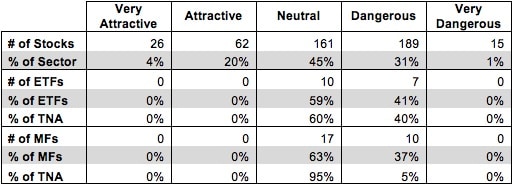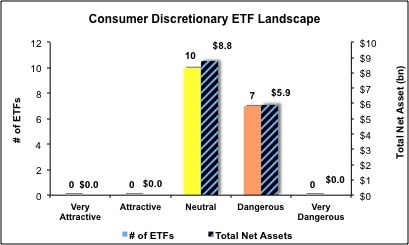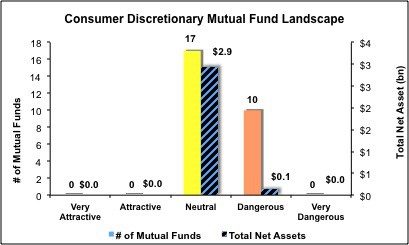The Consumer Discretionary sector ranks fifth out of the ten sectors as detailed in my Sector Rankings for ETFs and Mutual Funds report. It gets my Neutral rating, which is based on aggregation of ratings of 17 ETFs and 27 mutual funds in the Consumer Discretionary sector as of July 9, 2013. Prior reports on the best & worst ETFs and mutual funds in every sector are here.
Figures 1 and 2 show the five best and worst-rated ETFs and mutual funds in the sector. Not all Consumer Discretionary sector ETFs and mutual funds are created the same. The number of holdings varies widely (from 25 to 379), which creates drastically different investment implications and ratings. The best ETFs and mutual funds allocate more value to Attractive-or-better-rated stocks than the worst ETFs and mutual funds, which allocate too much value to Neutral-or-worse-rated stocks.
To identify the best and avoid the worst ETFs and mutual funds within the Consumer Discretionary sector, investors need a predictive rating based on (1) stocks ratings of the holdings and (2) the all-in expenses of each ETF and mutual fund. Investors need not rely on backward-looking ratings. My fund rating methodology is detailed here.
Investors should not buy any Consumer Discretionary ETFs or mutual funds because none get an Attractive-or-better rating. If you must have exposure to this sector, you should buy a basket of Attractive-or-better rated stocks and avoid paying undeserved fund fees. Active management has a long history of not paying off.
Get my ratings on all ETFs and mutual funds in this sector on my free mutual fund and ETF screener.
Figure 1: ETFs with the Best & Worst Ratings – Top 5
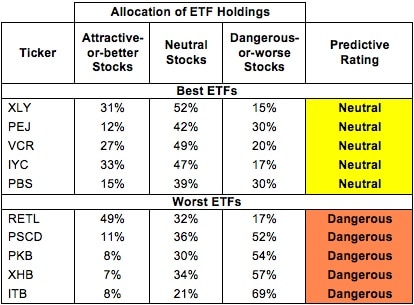
Sources: New Constructs, LLC and company filings
Market Vectors Retail ETF (RTH), Guggenheim S&P Equal Weight Consumer Discretionary (RCD), and PowerShares Dynamic Consumer Discretionary (PEZ) are excluded from Figure 1 because their total net assets (TNA) are below $100 million and do not meet our liquidity standards.
Figure 2: Mutual Funds with the Best & Worst Ratings – Top 5
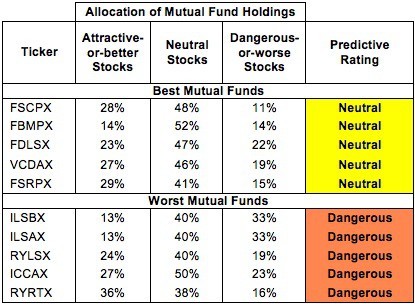
Sources: New Constructs, LLC and company filings
Four mutual funds are excluded from Figure 2 because their total net assets (TNA) are below $100 million and do not meet our liquidity standards.
Consumer Discretionary Select Sector SPDR (XLY) is my top-rated Consumer Discretionary ETF and Fidelity Select Portfolios: Consumer Discretionary Portfolio (FSCPX) is my top-rated Consumer Discretionary mutual fund. Both earn my Neutral rating.
iShares U.S. Home Construction ETF (ITB) is my worst-rated Consumer Discretionary ETF and Rydex Series Funds: Retailing Fund (RYRTX) is my worst-rated Consumer Discretionary mutual fund. Both earn my Dangerous rating.
Figure 3 shows that 88 out of the 453 stocks (over 24% of the market value) in Consumer Discretionary ETFs and mutual funds get an Attractive-or-better rating. However, no Consumer Discretionary ETFs or mutual funds allocate enough value to Attractive-or-better rated stocks to earn an Attractive rating.
The takeaways are: mutual fund managers allocate too much capital to low-quality stocks and Consumer Discretionary ETFs hold poor quality stocks.
Figure 3: Consumer Discretionary Sector Landscape For ETFs, Mutual Funds & Stocks
As detailed in “Cheap Funds Dupe Investors”, the fund industry offers many cheap funds but very few funds with high-quality stocks, or with what I call good portfolio management.
Investors need to tread carefully when considering Consumer Discretionary ETFs and mutual funds, as seven ETFs (40% of net assets) and 10 mutual funds (5% of net assets) in the Consumer Discretionary sector earn a Dangerous-or-worse rating. With so many Dangerous funds and no Attractive ones, investors are better off focusing on individual stocks instead.
Scripps Networks Interactive (SNI) is one of my favorite stocks held by Consumer Discretionary ETFs and mutual funds and earns my Very Attractive rating. SNI is a stable and profitable company, with an average return on invested capital (ROIC) of 20% over the past five years. SNI’s specialty TV programs and channels are succeeding in the increasingly subdivided TV market. SNI’s cable network unit grew advertising revenue by 11% last year compared to only 1% from competitor Time Warner (TWX) and 2% from Viacom (VIAB).
The good news for investors is that such a strong company is available at a cheap price. SNI is currently valued at ~$70.52/share. If it can grow revenue by 10% a year for five years (its growth rate over the past five years) and maintain its margins, SNI is worth over $86/share.
Amazon.com (AMZN) is one of my least favorite stocks held by Consumer Discretionary ETFs and mutual funds and earns my Dangerous rating. As I wrote back in May, Amazon’s margins are simply too low to support the kind of growth embedded in its stock price. Amazon’s operating profit (NOPAT) margin in 2012 was only 1%. Amazon lacks significant product differentiation. With low prices as the only major selling point, there’s not much room for it to expand those margins.
AMZN must significantly expand its margins to meet the lofty growth expectations embedded in its ~$290.59/share valuation. Even if AMZN can double its NOPAT margins, it would still need to grow NOPAT by 25% for 16 years to justify that valuation. At which point, its revenue would be nearly $1.4 trillion, or about three times Wal-Mart’s (WMT) revenue last year. Amazon itself is not a bad company, but at its current valuation it is a bad stock.
459 stocks of the 3000+ I cover are classified as Consumer Discretionary stocks, but due to style drift, Consumer Discretionary ETFs and mutual funds hold 453 stocks.
Figures 4 and 5 show the rating landscape of all Consumer Discretionary ETFs and mutual funds.
My Sector Rankings for ETFs and Mutual Funds report ranks all sectors and highlights those that offer the best investments.
Figure 4: Separating the Best ETFs From the Worst ETFs
Figure 5: Separating the Best Mutual Funds From the Worst Mutual Funds
Review my full list of ratings and rankings along with reports on all 17 ETFs and 27 mutual funds in the Consumer Discretionary sector.
Sam McBride contributed to this report.
Disclosure: David Trainer and Sam McBride receive no compensation to write about any specific stock, sector or theme.

